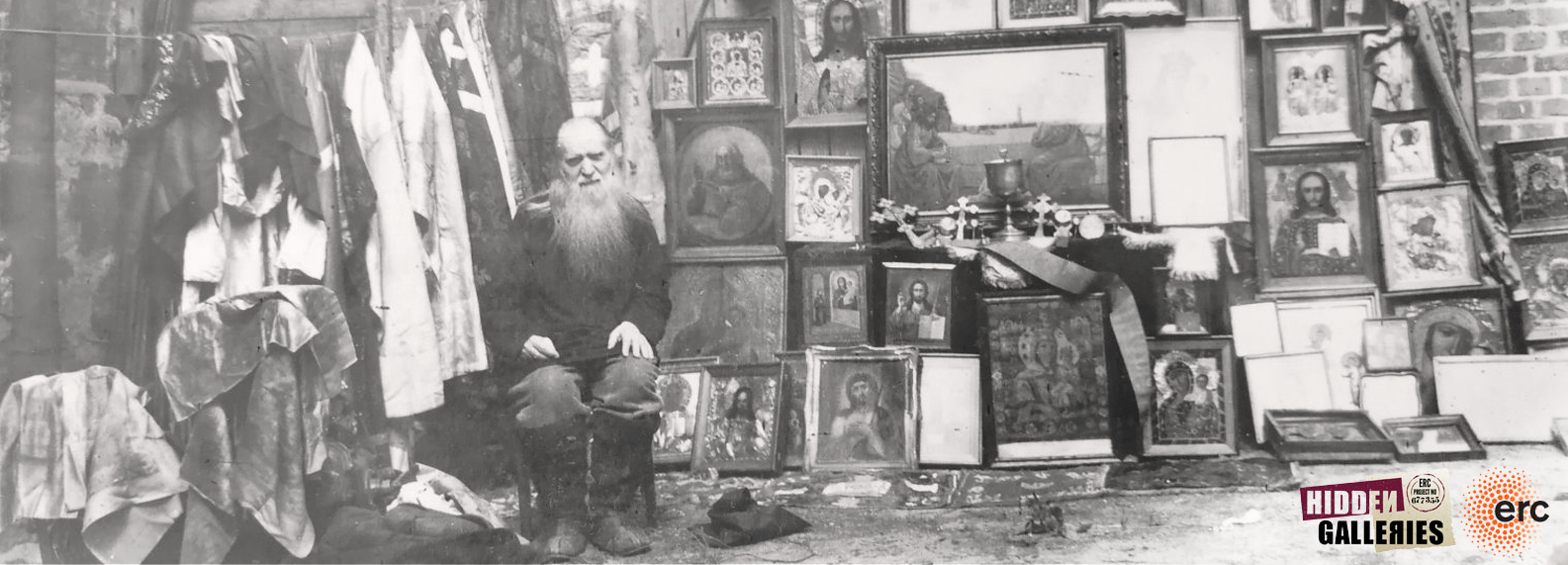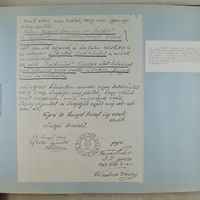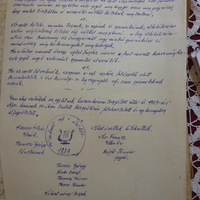Confiscated stamp of a Hungarian Calvinist Church Choir in Romania
Item
Title
Confiscated stamp of a Hungarian Calvinist Church Choir in Romania
A romániai Vízaknai Református Dalkör lefoglalt pecsétje 1973-ból
Description
The first image comes from a photo album compiled by the Securitate on the Hungarian Calvinist Church Choir in the town of Ocna Sibiului (Vízakna). It shows a photocopy of a confiscated document, the last page of the choir’s president’s celebratory speech performed at the choir’s 80th anniversary. As with many of the group’s documents, it bears the official stamp of the choir. The second photo shows a document with a hand drawn replica of this stamp. This document, which is the last page of a handwritten copy of the choir’s Rules and Regulations from 1974 (its original was written in 1956), is still kept in the local Calvinist church.
The stamp, along with a large part of the choir’s documentation was taken during a secret police raid in 1973 when authorities accused the choir of nurturing nationalist-irredentist ideals behind the façade of their church functions and of being hostile to the socialist Romanian state. It was claimed that the choir’s real aim was to maintain the national identity of the local Hungarian minority and to instil Hungarianess in the next generation. Although the choir was allowed to operate after the raid, it was “robbed of its past” since none of the confiscated items were returned. Some attempts were made to compensate for this loss: for example, several documents were recreated by the choir’s former secretary who, in lieu of the missing stamp, created a hand-drawn replica when necessary. This practice serves as an example of how groups that had been pursued by the secret police tried to cope with the loss of their belongings: in this case the loss of the choir's recorded history and an important symbol of its legitimacy, its stamp.
The Ocna Sibiului Calvinist Church Choir was founded in 1889. From 1907 it officially operated as an association with a president, secretary, accountant and had its own banner and stamp. Its main task was to sing at the funerals of congregation members and at church services but was also central to organising community life for local Hungarians. The choir still functions today.
The first image comes from file CNSAS D 015847. The second was taken during ethnographic fieldwork in 2018.
For related entries see:
The stamp, along with a large part of the choir’s documentation was taken during a secret police raid in 1973 when authorities accused the choir of nurturing nationalist-irredentist ideals behind the façade of their church functions and of being hostile to the socialist Romanian state. It was claimed that the choir’s real aim was to maintain the national identity of the local Hungarian minority and to instil Hungarianess in the next generation. Although the choir was allowed to operate after the raid, it was “robbed of its past” since none of the confiscated items were returned. Some attempts were made to compensate for this loss: for example, several documents were recreated by the choir’s former secretary who, in lieu of the missing stamp, created a hand-drawn replica when necessary. This practice serves as an example of how groups that had been pursued by the secret police tried to cope with the loss of their belongings: in this case the loss of the choir's recorded history and an important symbol of its legitimacy, its stamp.
The Ocna Sibiului Calvinist Church Choir was founded in 1889. From 1907 it officially operated as an association with a president, secretary, accountant and had its own banner and stamp. Its main task was to sing at the funerals of congregation members and at church services but was also central to organising community life for local Hungarians. The choir still functions today.
The first image comes from file CNSAS D 015847. The second was taken during ethnographic fieldwork in 2018.
For related entries see:
Az első kép a romániai Vízaknán működő magyar református dalkör titkosszolgálati dossziéjából származik. A képen annak az ünnepi beszédnek az utolsó oldalát láthatjuk, amelyet a kórus elnöke mondott a dalkör alapításának 80. évfordulóján, és amelyet a Szekuritáte egy házkutatás során lefoglalt. Hasonlóan a csoporttól elkobzott egyéb dokumentumhoz, ezen is látható a kórus hivatalos pecsétje. A második kép a kórus 1974-es keltezésű Alapszabályának utolsó oldaláról készült, amelyen ennek a pecsétnek a kézzal rajzolt másolata látható, és amelyet a mai napig a vízaknai református templom archívumában őriznek. A szabályzat eredetije 1956-ban íródott.
A pecsétet a kórus dokumentációjának nagy részével együtt a titkosrendőrség egy 1973-as rajtaütés során foglalta le, amikor is a kórust azzal vádolták, hogy templomi feladatai mögé bújva valójában nacionalista-irredenta nézeteket vall és ellenséges a szocialista román állammal szemben. A hatóságok azt állították, hogy a kórus igazi célja a helyi magyar közösség magyar nemzeti öntudatának fenntartása és a magyarsághoz való tartozás átörökítése a következő generációkra. Noha a kórus a titkosrendőrségi intézkedések után tovább működhetett, tagjai úgy érezték, megfosztották őket a múltjuktól, hiszen az ekkor elvitt tárgyak sosem kerültek vissza a közösséghez. A közösség egyes tagjai megpróbálták e veszteséget pótolni: a kórus korábbi titkára például újraírt bizonyos iratokat, amelyeken, ha szükséges volt, a hiányzó pecsétet kézzel rajzolta meg. Eljárása jó példa arra, hogy a titkosrendőrség által üldözött közösségek miképpen próbáltak megbirkózni kulturális javaik elvesztésével: ebben az esetben például írott emlékeik és legitimitásuk egyik fontos szimbólumának hiányával.
A Vízaknai Református Dalkört 1889-ben alapították a vízaknai református gyülekezet tagjai. 1907-ben egyesületté alakult, amelynek elnöke, titkára, könyvizsgálója, saját zászlója és pecsétje is volt. Bár elsődlegesen temetési és templomi kórusként működött, fontos szerepet játszott a helyi magyar közösség kulturális életében is. A kórus a mai napig aktív.
Forrás: CNSAS D 015847
Kapcsolódó bejegyzések:
Subject
Communism and Christianity--Europe, Eastern
Communism--Europe--History--20th century
Communism--Europe, Eastern--History--20th century
Secret police (secret service)
Surveillance
Totalitarianism
Religion and politics--Europe
Religion and state--Europe
Religious groups
Communism--Romania--History--20th century
Confiscations
Nationalism and communism
Nationalism--Romania--History
Romania. Securitatea
Creator
Agnes Hesz
Source
Consiliul Național pentru Studierea Arhivelor Securității
CNSAS D 015847
CNSAS D 015847
Publisher
This project has received funding from the European Research Council (ERC) under the European Union’s Horizon 2020 research and innovation programme No . 677355
Date
1973
Rights
The copyright for these images belongs to CNSAS
Format
jpg
Language
hu
ro
ro
Type
image
Identifier
CNSAS D 015847
Coverage
20th century
Romania, Transylvania
Romania, Transylvania
Bibliographic Citation
Agnes Hesz, "Confiscated stamp of a Hungarian Calvinist Church Choir in Romania,"
Date Created
2018


